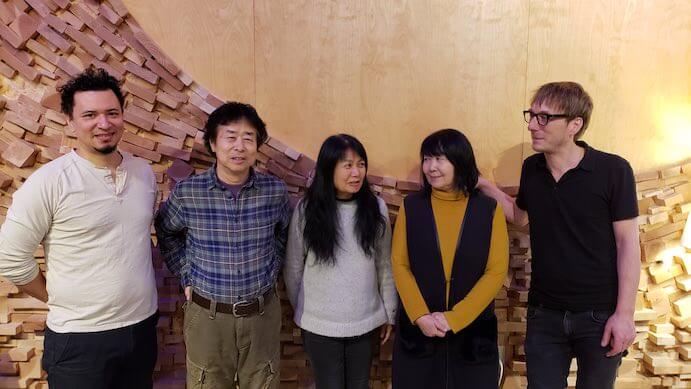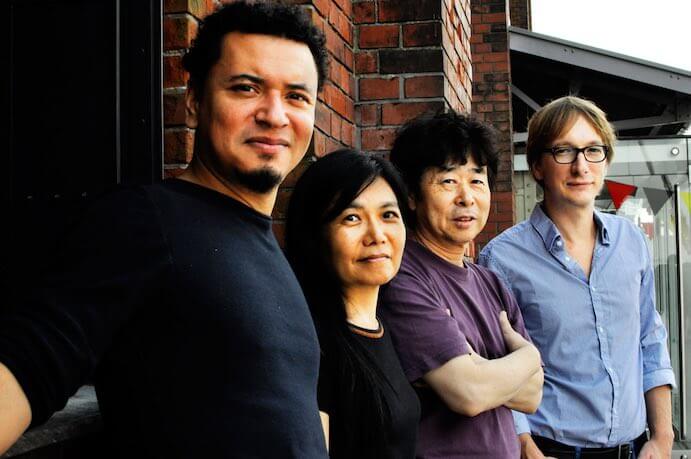Sand Storm, a collaboration between Kaze and Ikue Mori on Circum-Libra Records, opens like a sensory hurricane that carries you through unexpected peaks and valleys in a sonic ecosystem like no other. While the quartet, Kaze, has been performing for over a decade, laptop player Ikue Mori is a recent addition. The inclusion of Mori seems serendipitous, as her laptop melds seamlessly into the noisy free jazz cacophony and subtle ambient manipulations that propel Sand Storm to be a truly radical, immersive experience.
The opening burst of Christian Pruvost’s Rivodoza, which is Malagasy for “Hurricane,” lives up to its name. The intense intro quickly subdues to an intricate timbral experiment featuring a full spectrum of sound and noise from the duo of trumpets played by Pruvost and Natsuki Tamura. To call the sounds extended techniques would fail to do justice to the way the pair flawlessly weaves unfamiliar sounds and colors more familiar tones. Extended sections existing far beyond expectation give space to the subtle manipulation of material, most notably by drummer Peter Orins, whose simple shifting patterns and changes give the essential essence of time, and could go easily unnoticed as secondary to the trumpets and laptop.

Short improvisatory interludes fill the space between composed works, yet Poco a Poco, Under the Feet, and Suna Arashi each offer an insight into the group’s collaborations and bond with one another. Each improvisation explores a palate of vibrant environments, showcasing the ensemble’s specialized acuity and decision-making to shape hypnotic soundscapes. Suna Arashi, Japanese for “Sand Storm,” stands out as an unforgiving display of raucous layering and fierce gestures, constantly growing until an inevitable collapse. While Suna Arashi is the shortest work on the album, it is brilliant in its impact and succinct in its forceful intent.
Kappa, composed by Natsuki Tamura, gives space for the two trumpets to show not only their phenomenal technical prowess–blending unfamiliar textures into more traditional tones–but also their brilliant individuality as soloists. Tamura’s composition is powerful in its liberation of sound; the structure of the work and seamless integration of complex colors from noise to pitch breakdown the traditional hierarchy of music, allowing the listener to experience sound as sound. Throughout the work, Ikue Mori sets innovative and delicate textures with great acumen, none more compelling that the trio section with Peter Orins and Satoko Fujii (piano). The duo of drums and laptop play off one another to create an elaborate texture of spinning rhythmic finesse while Fujii adeptly selects colors, harmonies, and melodic contours, often sparse though dynamically placed. In her solo, Fujii highlights her artistry in stark contrast with the complex textures preceding her, entering with the fragility and gesture akin to Schoenberg.
Both Noir Poplar and Noir Soir, composed by Orins and Fujii respectively, feature explicit juxtapositions of sonic exploration and breathtaking explorations of time. The intricately detailed sound worlds in Noir Poplar become so compilatory that the source of sound becomes lost in the aura of the work; Orins creates a cohesive instrumental color while simultaneously allowing individuals’ voices to come forth from the texture in an other-worldly listening experience.

The subdued beginning of Noir Soir is gentle, but never comfortable. Fujii demonstrates subtle changes and control over time that viscerally leaves one breathless. Sudden changes from fragile to raw, simple to jagged, exploit the senses, throwing the listener into a complex labyrinth of layers and structures, culminating in an intense crescendo before fading to the most bizarrely fascinating vocal solo. Tamura becomes a man possessed in a performance of guttural, unintelligible, unhuman vocalizations one would expect to hear from a creature in a sci-fi movie. While Tamura’s vocal solo is wildly unsettling, the discomfort is intriguing in its whole-hearted, authoritative performance. Through this unhinged solo, Fujii does the impossible by adding a texture of simple, open harmonies in the piano and gentle melody in the trumpet, which feel as if they are the dissonance at work against Tamura’s vocals; everything is at once disturbing and entrancing.
Sand Storm never resolves, mostly because it is never dissonant. Sounds exist as they are and provide life and breath to a world its own. Contrasts and complements create the same harmony as the ebb and flow through time, free from what we often think of as traditional structures. Strained sounds shift from uncomfortable events to beautifully vibrant sonorities, while the most basic building blocks in Western harmony and melodic contour may feel invasive. The definition of experimental, Kaze Quartet and Ikue Mori’s Sand Storm exists as an apex in a musical world few dare to brave.
























